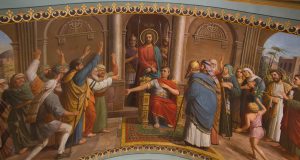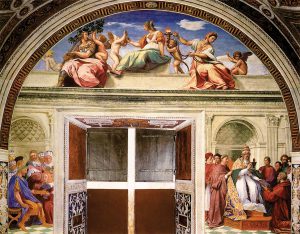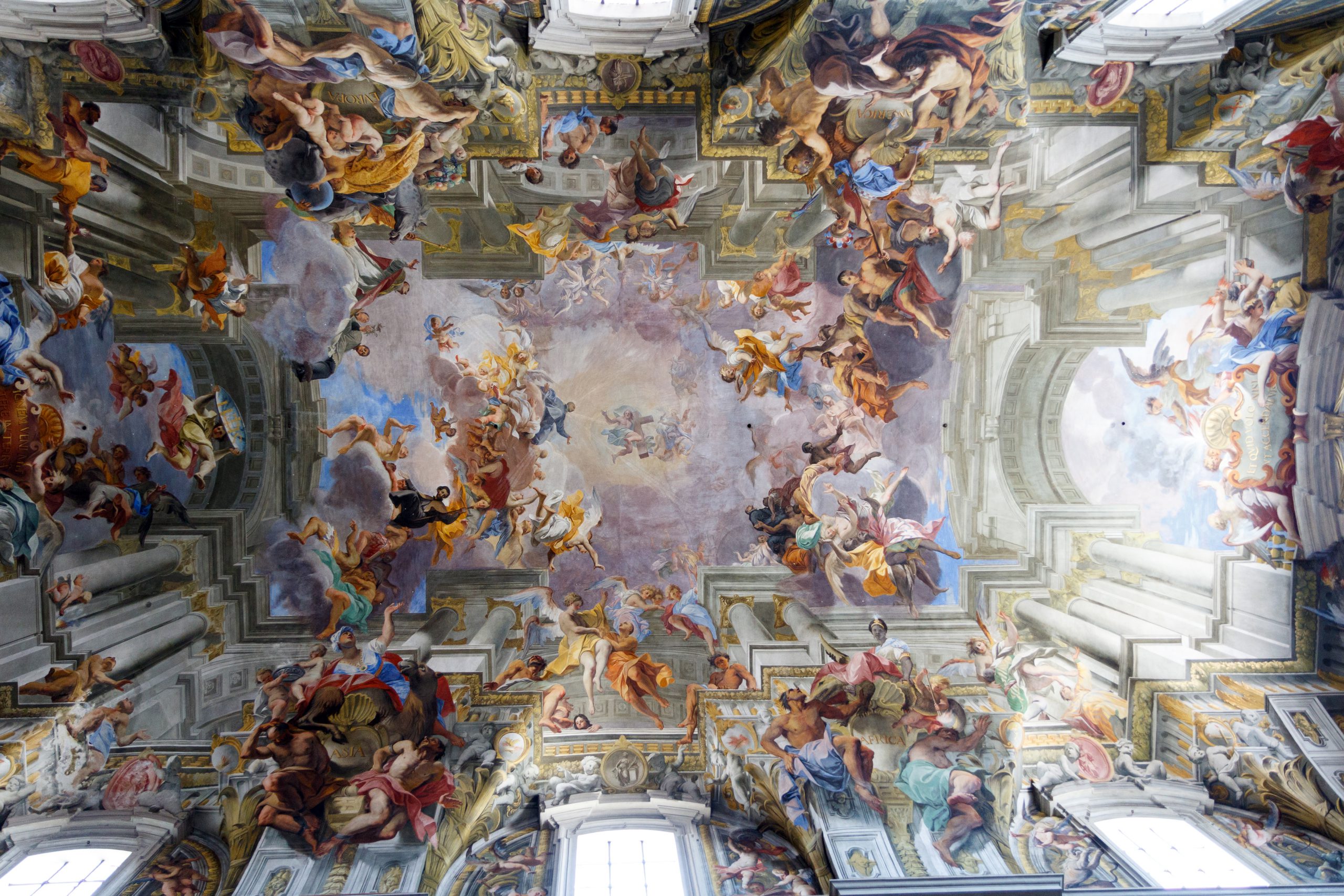
By Casey Bassett
Intercessory prayer is one of the many beautiful aspects of our faith. We not only pray for each other in this life, but we also seek the intercession of those who have gone before us who, as saints, share in the beatific vision of our Lord.
These saints have “God’s ear,” and their prayers are most certainly a boon for us who have yet to face our particular judgment. It is fitting that, whenever possible, we should seek out their intercession so that our Lord may be well disposed to our own prayers, sacrifices and spiritual growth.
As our Lord’s body was carefully preserved and venerated after his death, so too early Christians preserved the remains of the faithful and holy martyrs in catacombs beneath cities. Priests used the tombs of these holy martyrs as altars upon which they offered Mass, hoping to obtain the intercession of the faithful departed.
This continues in modern times where, according to the Code of Canon Law, “the ancient tradition of keeping the relics of martyrs and other saints under a fixed altar is to be preserved according to the norms given in the liturgical books” (Canon 1237). Additionally, many churches have reliquaries that house the remains of saints and martyrs outside of the altar for public veneration.
Various saintly relics slumber within the altars and reliquaries of the churches that make up our diocese. Beautiful stories and connections surround many of these saints and their relics. While this list is not exhaustive, let’s examine just a few.
St. Agnes
St. Agnes of Rome was martyred at a young age around the beginning of the fourth century. The details of her life vary according to the source, but her martyrdom was almost certainly a product of her unwillingness to renounce her faith to the Roman pagans. She was venerated almost immediately by the Church, and her name remains in the First Eucharistic Prayer of the Mass to this day.
Parishes with her relics: St. Agnes, Vermillion; her relics are brought out for public veneration around her feast day.
St. Ann
Ann or Anne is the name given to the mother of the Blessed Virgin Mary. Very little is known for certain about the life of St. Ann. However, early devotions to her, especially in the eastern churches, as well as a continued swelling of zeal for her throughout the ages in the western church tends to suggest that much was known of her that has since been lost and that her relics, carefully preserved by her devotees throughout the long centuries, are authentic.
Parishes with her relics: St. Ann, Geddes; St. Ann, Humboldt; Holy Spirit, Sioux Falls
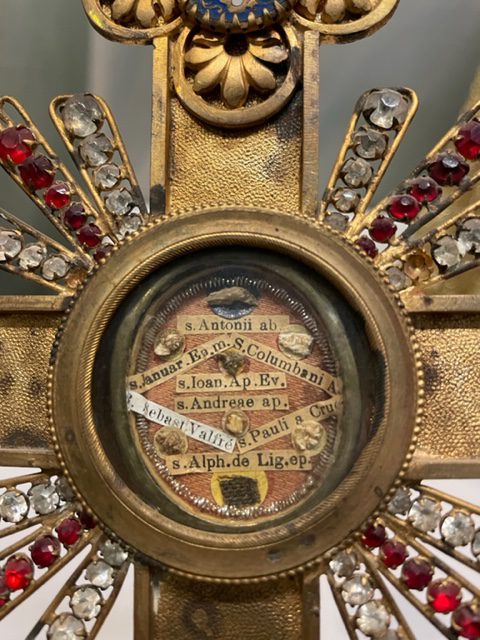
St. Elizabeth Ann Seton
While Catholic schools might be taken for granted today in the United States, we owe a debt of gratitude to St. Elizabeth Ann Seton for their success. Born in New York just prior to the American Revolutionary War, St. Elizabeth would eventually convert from Episcopalianism to Catholicism after the death of her husband. After her conversion, St. Elizabeth founded the first religious order for women in the United States as well as St. Joseph’s Academy and Free School, the entity from which modern Catholic schools in the U.S. find their genesis.
Father Richard Fox has a special devotion to St. Elizabeth Ann Seton, whose relics grace the private chapel at Immaculate Conception parish in Watertown.
“From 1981 to 1985, I was a seminarian at Mount St. Mary’s Seminary, just outside of the small town of Emmitsburg, Maryland. The body of St. Elizabeth Ann Seton is located at her national shrine in Emmitsburg, and I was granted the privilege of acquiring one of her first class relics,” Father Fox said. “Her relic now graces my private chapel in the rectory at Immaculate Conception, Watertown. I beseech her intercession to watch over and to guide our local Immaculate
Conception parochial school. St. Elizabeth Ann Seton, pray for us!”
Parishes with her relics: Immaculate Conception, Watertown; St. Lambert, Sioux Falls
St. Francis Xavier Cabrini
Mother Cabrini founded the Missionary Sisters of the Sacred Heart of Jesus and worked to build orphanages and institutes for the destitute, especially in New York and Chicago. Though born in Italy, she was sent on mission to the United States at the behest of the pope to serve the influx of immigrants. After her death in 1917, she would go on to become the first United States citizen to be canonized.
Parish with her relics: St. Paul the Apostle, White
Holy Roman Martyrs
These early Christians inhabited Rome during the reign of Nero in the latter half of the first century. After a fire destroyed a large swath of Rome, Nero turned his infamous and often irrational thirst for violence onto the Christian population. Many were killed in his circus spectacles using various forms of execution. Christians who managed to escape the atrocities were able to recover many of the victims, and their relics have been passed down to us today.
Parish with their relics: St. George, Hartford
St. Joseph
What higher purpose could a man strive for than protecting the Christ Child and his most Holy Mother? Yet, we find only a sentence or two in the Bible devoted to the activities of St. Joseph. It is in this sparsity, however, that a quiet, virtuous life can be seen. We can imagine a life marked with arduous labor to provide for the Holy Family in a harsh land.
His last and greatest task was the profound suffering he felt as he died knowing he would not be present to comfort the pierced heart of the Holy Mother as she gazed upon the crucifixion. His quiet life and suffering found its ultimate meaning and dignity in Christ’s Passion. There is little doubt that his prayers of intercession are a powerful ally for those today who toil as providers and protectors.
Parish with his relics: St. Ann, Geddes
St. Jude
St. Jude was one of the Twelve Apostles and author of the Epistle of St. Jude, a short letter found in the Bible just before the Book of Revelation. Besides his passionate exhortation in the letter against false teachers, little remains known about St. Jude.
Parish with his relics: St. Mary, Sioux Falls
St. Lawrence
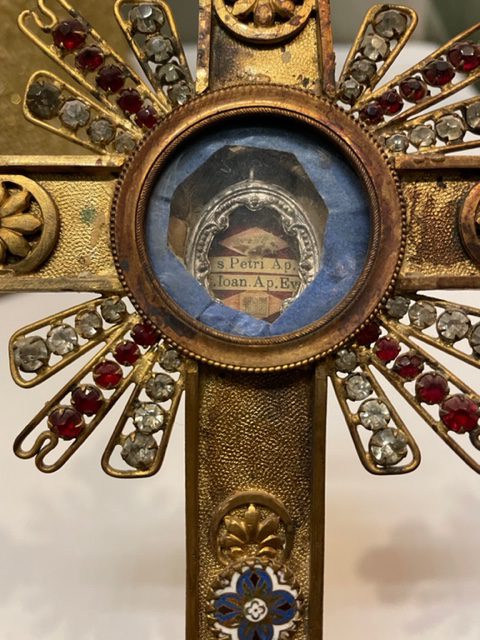
Arguably one of the most well-known early martyrs, St. Lawrence was a deacon serving in Rome during the persecution of the early Church. He was commissioned as the caretaker of the treasury of the Church and distribution of alms. It was because of these responsibilities that he was commanded by Roman authorities to hand over the treasures and riches of the Church. Instead of bringing money and gold, Lawrence brought the poor and neglected, presenting them as the true riches of the Church. For his defiance, Lawrence was martyred in the year 258 by being burned alive.
Parish with his relics: St. Lawrence, Milbank
St. Margaret Mary Alacoque
We owe the concept of a Holy Hour to St. Margaret Mary Alocoque who, in the mid 1600s, received visions of Christ expressing his desire that she spend an hour with him a week in honor of his isolation in the Garden of Gethsemane. She also helped form the modern devotion to the Sacred Heart, which was a recurring theme in her visions. As a professed nun in the Order of the Visitation of Holy Mary, her life was marked with humility, quiet asceticism and devotion to the holy Eucharist.
Parish with her relics: St. John the Baptist, Wagner
St. Maria Goretti
St. Maria Goretti was martyred at the turn of the 20th century. After courageously resisting the advances of a neighbor in the name of her faith, she was attacked by her assailant and subsequently spent several days on her deathbed suffering while clinging to her faith. At only 11 years old, the depth of her faith astounded the doctors and those around her. After her death, her assailant, Alessandro Serenelli, experienced a conversion while in prison after being visited by a local bishop and experiencing a profound dream. St. Maria’s canonization happened in 1950, and her relics are widely distributed as is evidenced by the number of parishes housing them.
Parishes with her relics: St. Bernard, Redfield; Cathedral of Saint Joseph, Sioux Falls; St. George, Hartford; Holy Spirit, Sioux Falls; St. Paul the Apostle, White; St. Wilfred, Woonsocket
St. Martin de Porres
Leading a life marked by extreme asceticism, St. Martin was a Dominican lay brother who served the sick and poor in Peru in the early 1600s. He was known to be quite resourceful and was often able to raise a good deal of funds for the poor and destitute. His quiet, diligent adherence to work, coupled with his success in building orphanages and hospitals, contributed to his cause for canonization.
Parish with his relics: Pope Pius XII Newman Center, Brookings; St. Vincent Ferrer’s relics are also found here

Pope St. Pius X
Reigning as pope from 1903 until his death in 1914, the depths of Pope St. Pius X’s internal personal humility and rigorous faith life were matched by his outward zeal for the piety of the faithful. He is known for his fervent promotion of Gregorian chant, his bold condemnation of the tentacles of modernism creeping into the Church, and his care for the sacramental life of the laity. St. Pius X was a fierce defender of the Catholic faith, which he saw as under attack by those in the Church capitulating to the demands of secularism and modern philosophies.
Parishes with his relics: Cathedral of Saint Joseph, Sioux Falls; St. Bernard, Redfield; St. John the Baptist, Wagner; St. Leo the Great, Tyndall
St. Rose of Lima
Even before she joined the Dominicans, St. Rose’s life was full of prayer and mortification. Known for her extreme beauty, she desired to profess vows and live a cloistered life from a young age. Though her parents initially opposed this life, they eventually relented, and she professed vows around the age of 20. She continued to live a life of nearly constant prayer and mortification until her death in 1617.
Parish with her relics: St. John the Baptist, Wagner
St. Therese of Lisieux
A life marked by simplicity and profound spiritual depth, St. Therese is perhaps best known for her “little way.” By striving to do small things perfectly, she worked toward spiritual perfection. It is in this “little way,” along with her devotion to the Holy Face and her willingness to bear suffering, that we find an undeniable example of how everyone, even the most ordinary, can strive for sainthood. St. Therese died at the age of 24 in 1897 after succumbing to a difficult illness.

Parish with her relics: St Lawrence, Milbank
St. Thomas of Canterbury (Thomas Becket)
On Dec. 29, 1170, Thomas Becket, the Archbishop of Canterbury, was violently murdered by four knights of King Henry II’s court. St. Thomas had formerly been friends with the king, but this friendship dissolved when the king tried to extend his authority to certain parts of the clergy. At the pinnacle of their disagreement, the king is said to have spoken words to his knights against the archbishop. The knights interpreted this as a command to kill the archbishop, which was carried out at Canterbury Cathedral. It was St. Thomas’s refusal to capitulate during his life and his heroic bravery when facing death that contributed to his cause for canonization, which was achieved just three years after his death.
Parish with his relics: Cathedral of Saint Joseph

True Cross
Romans had laid waste to Jerusalem during the first centuries after Christ’s death. It wasn’t until Constantine granted a level of tolerance for Christians that the holy places and artifacts in Jerusalem were able to be rediscovered and safeguarded for a time. Near the beginning of the fourth century, the cross of Christ was discovered and, after appropriate scrutiny, recognized as authentic. Through the ages, small splinters of wood from the true cross have been distributed and used, especially for veneration on Good Friday.
Parishes with these relics: St. John the Baptist, Wagner; St. Leo the Great, Tyndall
St. Vincent de Paul
This French priest lived during the 1600s and devoted much of his later life to ministering and serving the poor and incarcerated throughout France. He made such an impact on his companions and on those he served that he was canonized less than 100 years after his death in 1660.
Parishes with his relics: St. Katharine Drexel, Sioux Falls; St. Leo the Great, Tyndall
A holy ensemble
St. Bernard Parish in Redfield and St. Leo the Great Parish in Tyndall have a wonderful array of relics from various saints. In addition to some of the aforementioned relics, you can find the following at St. Bernard: St. Alphonsus Ligori, St. Andrew the Apostle, St. Anthony-Abbot, St. Columban, St. Francis de Sales, St. Francis of Assisi, St. Francis Xavier, St. Gemma, St. Januarius, St. John Bosco, St. John Paul II, St. John the Apostle, St. John Vianney, St. Paul of the Cross, St. Paul the Apostle, St. Peter, St. Phillip Neri, St. Sabina Virgin and Martyr, Bl. Sebastian Valfre.
In addition to those already described in this story, you can find the following relics at St. Leo the Great: St. Alphonsus Ligouri, St. Andrew, St. Anthony, St. Bernard, St. Blaze, St. Catherine, St. Charles Borromeo, St. Christopher, St. Columban, St. Constantia, St. Dominic Savio, St. Elizabeth of Hungary, St. Francis Xavier, St. Januarius, St. John, St. John Bosco, St. John Newman, St. Leo the Great, St. Paul of the Cross, St. Peter, St. Philip Neri, St. Roch, St. Sebastian Valfre, St. Teresa of Jesus, The Veil of the Blessed Virgin Mary (portion).
The saints triumphant rise in bright array
By their lives, the saints provide us with an example of the difficult but rewarding road we must traverse toward heaven. In their deaths and heavenly home, they pray unceasingly that we might strive to elevate our own lives and one day attain joyous union with God. The presence of their relics in our diocese is not only a reminder of their lives and prayers, but also a reminder of the timeless nature of the Church and the eternal truths that she manifests and protects, truths for which many of the saints mentioned here died.
As you answer the sweet but arduous call to lead a Christian life, perhaps you will find yourself gazing upon the relics of a hallowed saint. Pray that their lives might be your watch-word and their prayers your strength.

